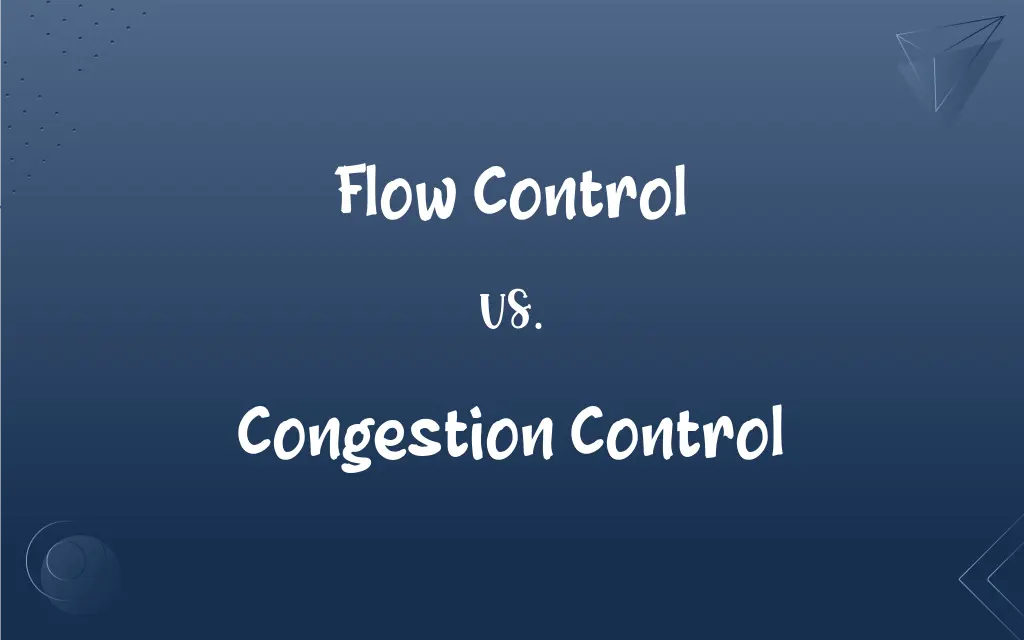Flow Control vs. Congestion Control: What's the Difference?
Edited by Aimie Carlson || By Harlon Moss || Updated on October 18, 2023
Flow control manages data transfer between sender and receiver, preventing buffer overflow. Congestion control prevents network overload by regulating traffic entry when a network segment reaches its capacity.

Key Differences
Flow control is a technique implemented in data communication to ensure that the data sender does not overwhelm the data receiver by sending too much data at once. This mechanism ensures that the sender transmits data at a rate the receiver can manage. Congestion control, on the other hand, is designed to prevent too much data from being introduced into a network, thereby preventing network performance degradation.
Flow control is mainly an end-to-end or a point-to-point mechanism, which means it's concerned with the rate of data exchange between two devices, ensuring the efficiency of the communication. Congestion control is concerned with how data is introduced into the network, ensuring that data packets do not overwhelm network resources, leading to a decline in network performance.
Flow control mechanisms often work by using feedback from the receiver to the sender. The receiver will indicate its readiness or capacity to receive data, thereby managing the flow. Congestion control works by recognizing signs of network congestion and then taking action to reduce the entry of data into the affected segment of the network.
In essence, while flow control ensures harmony between a data sender and receiver, congestion control ensures that the entire network operates efficiently, even when faced with high data traffic demands. Both concepts are critical in maintaining the reliability and efficiency of data networks.
Comparison Chart
Scope
Between sender and receiver
Network-wide
ADVERTISEMENT
Main Objective
Prevent buffer overflow at receiver
Prevent network performance degradation
Feedback Source
Receiver
Network elements (like routers)
Mechanism Purpose
Match sender's rate to receiver's processing ability
Regulate traffic entry during high demand
Influence
Operates on end-to-end or point-to-point basis
Operates on a segment or entirety of the network
Flow Control and Congestion Control Definitions
Flow Control
Flow control prevents data sender from overwhelming the receiver's buffer.
The computer utilized flow control to manage incoming data and avoid crashes.
ADVERTISEMENT
Congestion Control
Congestion control prevents data traffic from overwhelming network resources.
The network utilized congestion control algorithms to avoid slowdowns during peak hours.
Flow Control
Flow control uses feedback to regulate data sending rate.
By employing flow control, the protocol adjusted data transmission based on recipient feedback.
Congestion Control
Congestion control acts upon signs of network saturation to restore efficiency.
When the video conference had too many participants, congestion control stabilized the connection by adjusting data flow.
Flow Control
Flow control ensures data is transmitted at a rate a receiver can handle.
In streaming, flow control prevents video stuttering by matching data sending speed to the user's bandwidth.
Congestion Control
Congestion control detects and remedies network traffic excesses.
Congestion control identified high traffic on the router and redirected some data to maintain speed.
Flow Control
Flow control balances data transmission speed to avoid data loss.
Flow control mechanisms in the application stabilized data transfer, ensuring all packets arrived intact.
Congestion Control
Congestion control is a network-wide strategy to avoid performance degradation.
With effective congestion control, the internet provider ensured consistent speeds even on high-demand days.
Flow Control
Flow control is an end-to-end mechanism ensuring harmonized data exchange.
Due to effective flow control, both servers exchanged data seamlessly despite different processing capacities.
Congestion Control
Congestion control maintains network performance by regulating traffic entry.
To avoid data bottlenecks, congestion control mechanisms reduced packet entry into the main server.
FAQs
How does congestion control differ from flow control?
Congestion control prevents network overload, while flow control prevents receiver buffer overflow.
What is flow control?
It ensures data is sent at a rate a receiver can handle.
How do routers relate to congestion control?
Routers use congestion control algorithms to manage data traffic and prevent network overloads.
Is flow control specific to any data communication type?
No, it's applicable in various communication types, from streaming to data transfers.
Are there different methods of flow control?
Yes, methods include window-based and rate-based flow control.
Do all communication protocols implement flow control?
Most do, as it's vital for ensuring reliable data communication.
flow control or congestion control?
Congestion control, as it requires monitoring and managing an entire network segment or the whole network.
In what scenarios is congestion control critical?
During high network traffic, to maintain consistent speeds and avoid data bottlenecks.
What are the signs that congestion control might be needed?
Slow network speeds, data bottlenecks, and frequent data packet drops.
How does congestion control identify network congestion?
By monitoring network traffic and detecting signs of overload or slowdown.
How does congestion control benefit end-users?
By providing consistent network speeds and reducing data transfer interruptions.
Can flow control operate without feedback?
Typically, no. Feedback is essential for adjusting data transmission rates.
Is flow control always receiver-initiated?
Mostly, as the receiver provides feedback on its data processing capacity.
Why is flow control necessary?
To ensure the sender doesn't send data faster than the receiver can process.
How does flow control work?
By using feedback from the receiver to regulate the sender's data transmission rate.
Can flow control lead to network congestion?
Not directly, but inadequate flow control can strain receivers, which might indirectly affect the network.
What's the outcome of effective congestion control?
Smooth network performance, even during high data traffic periods.
What's the main goal of congestion control?
To maintain optimal network performance by preventing and mitigating traffic overloads.
Can a system implement both flow control and congestion control?
Yes, they often work together to ensure efficient data transmission.
What happens if congestion control is not implemented in a busy network?
Network performance may degrade, causing slow speeds and potential data loss.
About Author
Written by
Harlon MossHarlon is a seasoned quality moderator and accomplished content writer for Difference Wiki. An alumnus of the prestigious University of California, he earned his degree in Computer Science. Leveraging his academic background, Harlon brings a meticulous and informed perspective to his work, ensuring content accuracy and excellence.
Edited by
Aimie CarlsonAimie Carlson, holding a master's degree in English literature, is a fervent English language enthusiast. She lends her writing talents to Difference Wiki, a prominent website that specializes in comparisons, offering readers insightful analyses that both captivate and inform.































































